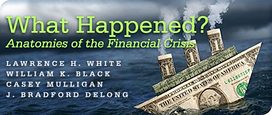Professor Black claims that “Rome is burning,” which I take to mean that we are in the midst of an economic disaster, and claims that I ignore it because of a theoretical bias.
2008 has been a disaster for Wall Street. A couple of years of steeply rising oil prices has been bad for the automobile industry, and a disaster for the makers of gas guzzlers — namely, GM, Chrysler, and Ford. However, I admit — proclaim — that I do not see 2008 as an economic disaster for the average American. We will see what 2009 will bring, but my characterization of 2008 is largely based on data.
First let’s look at the employment data through November. Employment is down about 2 million, which undoubtably creates stress for a couple of million families. But is that a disaster? Robert Hall and Susan Woodward have a chart comparing the employment dynamics today to the 1982 recession, and find that, in percentage terms, employment declined more rapidly in 1982.
By 1982 Q1, productivity had fallen 3 of 4 quarters for a cumulative decline of 2.3 percent. Through 2008 Q3, productivity had risen six consecutive quarters, with an increase of 2.1 percent over the past four. It is very likely that the U.S. will have the most real GDP per capita in its history in 2008, despite the fact that the entire year will be spent in recession (by the employment definition). [1]
Even the more gloomy forecasts for the next year do not portend disaster. At quarterly rates, GDP growth, Goldman Sachs says, will fall 5/4 percent, 3/4 percent, and 1/4 percent from 2008Q3-Q4, 2008Q4-2009Q1, and 2009Q2. That’s a cumulative decline of 2.3 percent 2008Q3 – 2009Q2, or $200 billion, or about $700 per person. Is that a disaster?
Note
[1] Through Q3, 2008 GDP was $8,771 billion (seasonally adjusted by the BEA). 2008 population (July) was 303,824,640, so 2008 produced $28,870 per person already through Q3. That means only $9,338 per capita ($2,837 billion in aggregate) needs to be produced in Q4 to break the 2007 record. In other words, if Q4 is within 3 percent of Q3, we break the record. Even the most pessimistic forecasters admit that Q4 real GDP will be greater than that.

